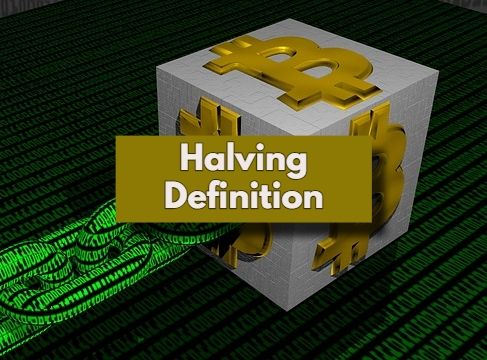Halving – definition. Discover the principle of halving, its characteristics and its impact in the cryptocurrency world.
Halving is a much-used word, but what exactly does it mean, and does it only apply to Bitcoin?
Little discussion between friends about halving:
Paul: Hi Emma! Have you heard about halving lately?
Emma: Hi Paul! Yes, I’ve heard about it. It’s the event that took place in the cryptocurrency market, right?
Paul: Exactly! It’s a crucial event for cryptos like Bitcoin. Do you have any idea what it is?
Emma: Hmm, I’d say it’s when the price of Bitcoin reaches half its value?
Paul: Not exactly. Halving is actually about rewarding miners for mining new blocks in the Bitcoin blockchain. At regular intervals, this reward is halved.
Emma: Ah, I see. So this means that miners receive less bitcoin for each block they extract?
Paul: Exactly! This directly affects the supply of bitcoins on the market. Fewer bitcoins are created, which can potentially increase their long-term value.
Emma: Interesting. How often has halving already occurred for Bitcoin?
Paul: So far, there have been three halvings for Bitcoin. The last one took place in 2020, reducing the miners’ reward to 6.25 bitcoins per block.
Emma: Wow, I didn’t know that happened regularly. Do other cryptocurrencies also have halvings?
Paul: Yes, some do.Litecoin, for example, has regular halvings, as do a few others.It’s a measure designed to control supply and maintain the value of the cryptocurrency.
Emma: That’s fascinating!Thanks for the explanation, Paul.You’re really well-informed on the subject.
Paul: You’re welcome, Emma! Always a pleasure to discuss cryptocurrencies with you.
Interested in finding out more?
If you like decentralized Bitcoin trading, or simply own some or want to, then you should take this event into consideration, find out why?
Halving – definition:
Halving, also known as « halving », is an event programmed into the protocol of certain cryptocurrencies, such as Bitcoin. It consists in halving the reward given to miners for creating new blocks on the blockchain.
In the context of Bitcoin, for example, halving Bitcoin occurs approximately every four years, or more precisely every 210,000 blocks mined. Initially, the reward for mining a block was 50 bitcoins. During the first halving in 2012, this reward was halved to 25 bitcoins. Then, at the second halving in 2016, the reward dropped to 12.5 bitcoins. The latest halving took place in 2020, reducing the reward to 6.25 bitcoins.
Halving has important implications for the supply of the cryptocurrency concerned. By reducing the reward for mining new blocks, it slows the creation of new units of the cryptocurrency, helping to control its supply and potentially increase its value by reducing supply inflation on the market. This can also influence miners’ incentive to participate in the network, as the reward decreases, which can lead to a temporary decrease in the rate of new block creation until the network adjusts.
Does halving only concern Bitcoin?
Many other cryptocurrencies use halving or reward reduction mechanisms similar to Bitcoin’s. Some of the most popular and well-known cryptocurrencies that have programmed halvings or similar mechanisms include:
Litecoin (LTC): Litecoin is often considered to be one of the first cryptocurrencies to have implemented halving, which occurs approximately every four years, much like that of Bitcoin.
Bitcoin Cash (BCH): Bitcoin Cash, a fork of Bitcoin, also uses a halving mechanism similar to that of Bitcoin.
Bitcoin SV (BSV): Like Bitcoin Cash, Bitcoin SV follows the same halving model as the original Bitcoin.
Zcash (ZEC): Zcash is a privacy-oriented cryptocurrency that also uses a reward-reduction system for its miners.
Dash (DASH): Dash, a cryptocurrency focused on transaction speed and confidentiality, uses a reward reduction mechanism similar to that of Bitcoin.
There are other cryptocurrencies that use similar supply control mechanisms, but these examples are among the most popular that have halvings or periodic reward reductions like Bitcoin.
When did the first halving take place and what were the consequences?
The consequences of the first halving were manifold:
- Reduced supply of new bitcoins: By halving the reward for miners, halving contributed to slowing down the creation of new bitcoins. This had the effect of reducing bitcoin supply inflation on the market.
- Potential increase in value: As a result of the reduced supply of new Bitcoins, some investors have speculated that this could lead to an increase in Bitcoin’s long-term value. This anticipation has sometimes led to higher prices even before the halving has occurred.
- Impact on mining profitability: For miners, halving halved their Bitcoin reward for each block mined. This meant they had to work twice as hard to obtain the same quantity of bitcoins, making some mining operations less profitable, particularly those using less efficient equipment or with high electricity costs.
Overall, Bitcoin’s first halving was a major event that impacted the cryptocurrency economy and ecosystem. It also marked the start of a regular cycle of halvings that continues to influence the cryptocurrency landscape today.
What impact does a halving generally have on the crypto network?
Halving generally has several impacts on the cryptocurrency network:
- Reduced supply of new coins: Halving halves the reward for miners, meaning they receive less cryptocurrency for their work. This leads to a decrease in the amount of new cryptocurrency introduced into the network, which can potentially reduce supply inflation and lead to increased scarcity in the long term.
- Potential increase in value: Due to the reduced supply of new coins, some investors anticipate an increase in the value of the cryptocurrency concerned in the long term. This can lead to higher prices even before halving occurs, and potentially afterwards.
- Impact on mining profitability: For miners, halving means a reduction in revenue, which can make certain mining operations less profitable. This may lead to a reduction in the number of miners operating on the grid, particularly those using less efficient equipment or facing high electricity costs.
- Adjusting mining difficulty: To maintain the pace of block creation despite reduced reward, many cryptocurrency protocols automatically adjust mining difficulty after halving. This ensures that the speed at which new blocks are added to the blockchain remains relatively constant.
Overall, halving is a major event in the life of a cryptocurrency, with significant repercussions for its economy, network and ecosystem. It is often closely scrutinized by investors, miners and market observers for its potential to influence the price and dynamics of the cryptocurrency concerned.
Conclusion about this event:
In conclusion, this is a crucial event in the cryptocurrency ecosystem, with significant repercussions for the network, the economy and the value of the digital assets involved. It represents a key step in the process of regulating cryptocurrency supply, helping to maintain scarcity and potentially boost long-term value.
This event represents a process that reduces miners’ rewards, which can affect their profitability and influence the rate at which new blocks are created on the blockchain.It also has an impact on the supply of new coins introduced to the market, which can lead to changes in supply and demand dynamics.
As a result, this event is being closely watched by players in the cryptocurrency industry, including investors, miners and developers. It can generate increased volatility in the market, but also offer opportunities for those who understand its long-term implications.
Overall, this is a key event that is helping to shape the future of cryptocurrencies, influencing their value, adoption and long-term viability in the global digital economy.


2 commentaires sur « Halving – definition »
Les commentaires sont fermés.